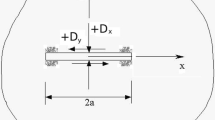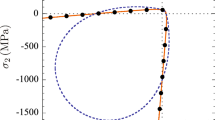Abstract
This article aims to answer two related sets of questions. First: in principle, how large an effect can structure at the atomic scale have upon the fracture of two macroscopically identical samples? The answer to this question is that the effects can be very large. Perfectly sharp cracks can be pinned and stationary under loading conditions that put them far beyond the Griffith point. Crack paths need not obey the rule K II=0. Crack speeds can vary from zero to the Rayleigh wave speed under identical loading conditions but depending upon microscopic rules. These conclusions are obtained from simple solvable models, and from techniques that make it possible to extrapolate reliably from small numerical calculations to the macroscopic limit. These techniques are described in some detail. Second: in practice, should any of these effects be visible in real laboratory samples? The answer to this second question is less clear. The qualitative phenomena exhibited by simple models are observed routinely in the fracture of brittle crystals. However, the correspondence between computations in perfect two-dimensional numerical samples at zero temperature and imperfect three-dimensional laboratory specimens at nonzero temperature is not simple. This paper reports on computations involving nonzero temperature, and irregular crack motion that indicate both strengths and weaknesses of two-dimensional microscopic modeling.
Similar content being viewed by others
References
Abraham, F. F., N. Bernstein, J. Q. Broughton and D. Hess (2000). Dynamic fracture of silicon: concurrent sim-ulation of quantum electrons, classical atoms, and the continuum solid. Materials Research Society Bulletin 25(5), 27–32.
Abraham, F. F., D. Brodbeck, R. A. Rafey and W. E. Rudge (1994). Instability Dynamics of Fracture: A Computer Simulation Investigation. Physical Review Letters 73(2), 272–275.
Adda-Bedia, M., M. Arias, M. B. Amar and F. Lund (1999). Generalized Griffith criterion for dynamical fracture and the stability of crack motion at high velocities. Physical Review E 60, 2366–2376..
Baskes, M. I. (1992). Modified embedded-atom potentials for cubic materials and impurities. PRB 46, 2727–2742.
Baskes, M. I., J. E. Angelo and C. Bisson (1994). Atomistic Calculations of Composite Interfaces. Modelling and Simululation in Materials Science and Engineering 2, 505–518.
Deegan, R. D., S. Chheda, L. Patel, M. Marder, H. L. Swinney, J. Kim and A. de Lozanne (2003). Wavy and rough cracks in silicon. Physical Review E 67,066209.
Freund, L. B. (1990). Dynamic Fracture Mechanics. Cambridge: Cambridge University Press.
Gerde, E. (2001). Fracture and Friction. Ph.D. thesis, The University of Texas at Austin.
Goldstein, R. V. and R. Salganik (1974). Brittle fracture of solids with arbitrary cracks. International Journal of Fracture 10, 507–523.
Griffith, A. (1920). The phenomena of rupture and flow in solids. Mechanical Engineering A221, 163–198.
Hauch, J., D. Holland, M. Marder and H. L. Swinney (1999). Dynamic Fracture in single-crystal silicon. Physical Review Letters 82, 3823–3826.
Hauch, J. and M. Marder (1998). Energy Balance in Dynamic Fracture, Investigated by a Potential Drop Technique. International Journal of Fracture 90, 133–151.
Heizler, S.I., D.A. Kessler and H. Levine (2002). Mode-I fracture in a nonlinear lattice with viscoelastic forces. Physical Review E 66 016126/1-10.
Hodgdon, J. A. and J. P. Sethna (1993). Derivation of a general three-dimensional crackpropagation law: a generalization of the principle of local symmetry. Physical Review B 47, 4831–4840.
Holian, B. L. and R. Ravelo (1995). Fracture simulations using large-scale molecular dynamics. Physical Review B 51, 11275–11288.
Holland, D. and M. Marder (1998a). Erratum (Ideal brittle fracture of silicon studied with molecular dynamics. Physical Review Letters 81, 4029.
Holland, D. and M. Marder (1998b). Ideal brittle fracture of silicon studied with molecular dynamics. Physical Review Letters 80, 746–749.
Holland, D. and M. Marder (1999). Cracks and atoms. Advanced Materials 11, 793–806.
Hsieh, C. and R. Thomson (1973). Lattice theory of fracture and crack creep. Journal of Applied Physics 44, 2051–2063.
Landau, L. D. and E. M. Lifshitz (1980) Statistical Physics, Part 1. Oxford: Pergamon Press, third edition.
Lin, I. H. and J. P. Hirth (1982). On brittle crack advance by double kink nucleation. Journal of Materials Science 17, 447–460.
Lutsko, J. F. (1988). Stress and elastic constants in anisotropic solids: Molecular dynamics techniques. Journal of Applied Physics 64, 1152–1154.
Marder, M. (1996). Statistical Mechanics of Cracks. Physical Review E 54, 3442–3454.
Marder, M. (1998). Energies of a kinked crack line. Journal of Statistical Physics 93, 511–525.
Marder, M. and S. Gross (1995). Origin of crack tip instabilities. Journal of the Mechanics and Physics of Solids 43, 1–48.
Marder, M. and X. Liu (1993). Instability in Lattice Fracture. Physical Review Letters 71, 2417–2420.
Markworth, A. J. and J. P. Hirth (1981). An atomistic model of crack extension by kink propagation. Journal of Materials Science 16, 3405–3417.
Oleaga, G. E. (2001). Remarks on a basic law for dynamic crack propagation. Journal of the Mechanics and Physics of Solids 49, 2273–2306.
Sinclair, J. E. (1975). The influence of the interatomic force law and of kinks on the propagation of brittle cracks. Philosophical Magazine 31, 647–671.
Slepyan, L. (1981). Dynamics of a crack in a lattice. Soviet Physics Doklady 26, 538–540.
Slepyan, L. I. (2002). Models and Phenomena in Fracture Mechanics. Berlin: Springer.
Spence, J. C. H., Y. M. Huang and O. Sankey (1993). Lattice trapping and surface reconstruction for silicon cleavage on (111). ab initio quantum molecular dynamics calculations. Acta Metallurgica 41, 2815–2824.
Sutton, M. A., X. Deng, F. Ma, J. Newman and M. James (2000). Development and application of a crack tip opening displacement-based mixed mode fracture criterion. International Journal of Solids and Structures 37, 3591–3618.
Swadener, J., M. Baskes and M. Nastasi (2002). Molecular dynamics simulation of brittle fracture in silicon. Physical Review Letters 89(8), 085503/1–4.
Thomson, R. (1986). The Physics of fracture. Solid State Physics 39, 1–129.
Thomson, R., C. Hsieh and V. Rana (1971). Lattice Trapping of Fracture Cracks. Journal of Applied Physics 42(8), 3154–3160.
Thomson, R., V. K. Tewary and K. Masuda-Jindo (1987). Theory of chemically induced kink formation on cracks in silica. I. 3-D crack Green's functions. Journal of Materials Research 2, 619–630.
Verlet, L. (1967). Computer ‘Experiments’ on Classical Fluids. I. Thermodynamical Properties of Lennard-Jones Molecules. Physical Review 159, 98.
Washabaugh, P. D. and W.G. Knauss (1994). A reconciliation of dynamic crack velocity and Rayleigh wave speed in isotropic brittle solids. International Journal of Fracture 65, 97–114.
Willis, J. R. (1967). Crack propagation in viscoelastic media. Journal of Mechanics and Physics of Solids 15, 229–240.
Yoffe, E. H. (1951). The Moving Griffith Crack. Philosophical Magazine 42, 739–750.
Author information
Authors and Affiliations
Rights and permissions
About this article
Cite this article
Marder, M. Effects of atoms on brittle fracture. International Journal of Fracture 130, 517–555 (2004). https://doi.org/10.1023/B:FRAC.0000049501.35598.87
Issue Date:
DOI: https://doi.org/10.1023/B:FRAC.0000049501.35598.87




